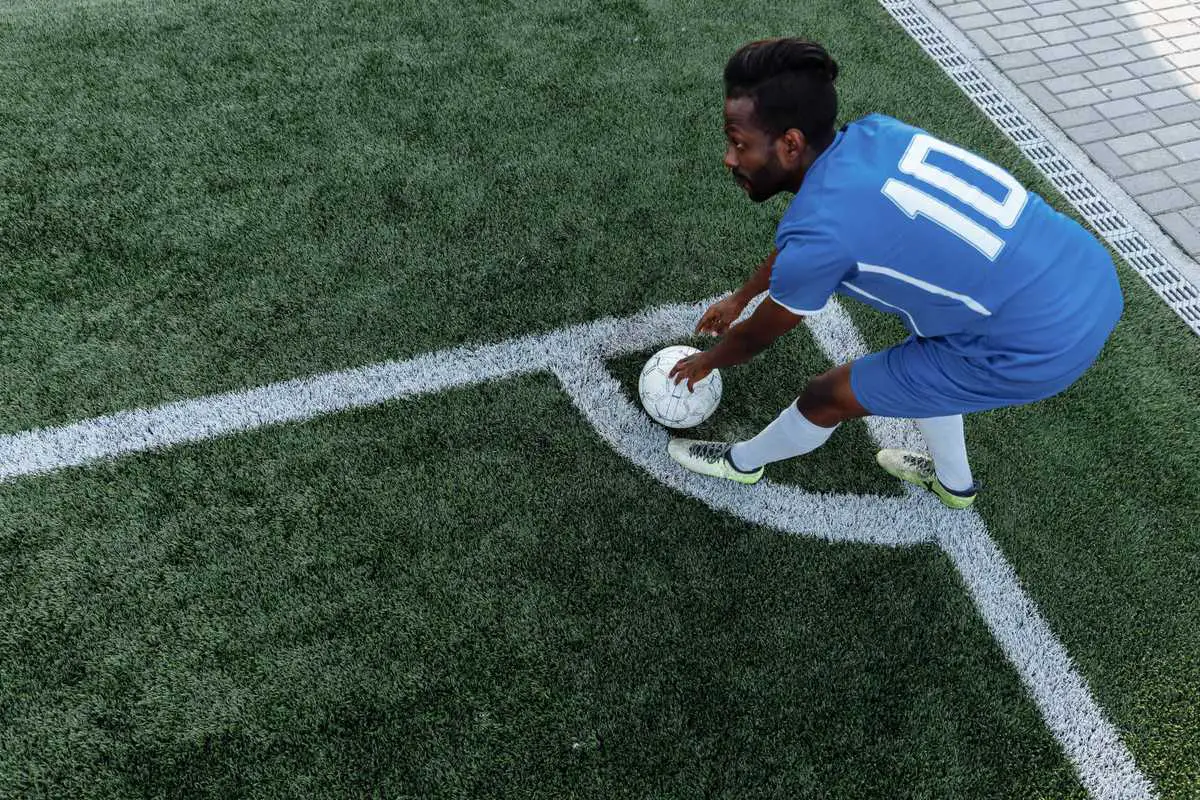What Is a Corner Kick in Football?

A corner kick is one of many ways that the game restarts once the ball leaves the field of play. The corner kick provides a way of returning possession to the offensive team, in an advanced area of the pitch. It is seen as a good opportunity for the offensive team to launch an attack and score a goal. However, when looking at the statistics, only 3-4% of corners will result in a goal.
When Is a Corner Kick Awarded?
If the whole of the ball exits the pitch by crossing over the goal line (or byline), there are two options for restarting play. One option is a goal kick, and the other is a corner kick. If the last player to touch the ball before it crosses the goal line was on the defensive team, then a corner kick is awarded. Conversely, if the last touch was from a player of the offensive team, then a goal kick is awarded. It does not matter if the touch that causes the ball to cross the goal line was deliberate.
"A corner kick is awarded when the whole of the ball passes over the goal line, on the ground, or in the air, having last touched a player of the defending team, and a goal is not scored."
There are also some rare scenarios when a corner kick is awarded when a defensive player puts the ball into their own goal directly from a kick-off, a free kick (direct or indirect), a throw-in, a goal kick, or a corner kick.
Corner Kick Procedure
- The corner kick must be taken from the corner that is nearest to the point where the ball crossed the goal line. For example, if the ball crosses the goal line to the left of the goal, then the kick must be taken from the corner to the left of the goal.
- The ball must be positioned within the corner area when taken.
- The ball must be stationary when the corner kick is taken.
- The ball becomes in play when it is kicked and it clearly moves. There is no need for the ball to leave the corner area.
- The corner flag must not be moved or removed when taking the kick.
- Opposing players must be standing at least 9.15 meters (10 yards) away from the corner circle when the kick is taken. This is to ensure that the corner taker has an unobstructed path to make a pass to a teammate.

Corner Kick Offences
- After taking a corner kick, the kicker must not touch the ball again before it has been touched by another player. If they do, an indirect free kick is awarded to the opposition.
- If the kicker deliberately kicks the ball at an opponent (without excessive force), in order to play the ball again (to bypass rule 1 above), the referee will allow play to continue.
- If a player excessively delays the taking of a corner kick, they should be cautioned with a yellow card.
- If the kick is taken from the wrong place, or if the ball is moving when taken, the kick should be retaken.
- If opposing players do not position themselves further than the required distance (see above) when the corner kick is being taken, then they could be cautioned with a yellow card.

Attacking Corner Strategies
The most common strategy for an offensive corner is for the kicker to cross the ball into the penalty area, where their teammates will attack the ball and attempt to score a goal, usually via a header. This strategy is most effective when the tallest players in the team are positioned in the penalty area, so it is common for the defensive centre backs to temporarily move up the pitch for a corner kick.
Short Corner
An alternative strategy is known as a 'short corner'. In this scenario, the kicker will not directly cross the ball into the penalty area but instead play a short pass to a teammate near the corner area, and then the team will attempt to work the ball toward the goal with a series of shorter passes. This strategy is more popular with teams that adhere to a more technical, passing philosophy, or teams that do not have players that are tall and strong in the air. It can also be used by a team that is leading the game for the purpose of wasting time. Playing short passes in the corner of the pitch makes it difficult for the opposing team to win the ball back, thus running down the clock.
Hand Signals
It is often a good strategy for the attacking team to have hand signals that will indicate where the corner taker will be delivering the ball. For example, some takers will raise one arm in the air to indicate that they will be delivering the ball shorter, to the near post, and raise both arms for a longer delivery to the far post. This way, all of the attacking players can prepare their runs into the penalty box to try to be one step ahead of the defending players.
Obstructing the Goalkeeper
When a corner kick is crossed in the air, the goalkeeper on the defending team can easily rush out to catch the ball or punch it away to safety. For this reason, it is a good strategy for the offensive team to designate a player to stand in front of the goalkeeper to try to prevent them from easily reaching the ball as it is delivered. This is a valid strategy and is within the rules, as long as the obstructing player does not use excessive force or use their hands to physically pull or push the goalkeeper.
Trick Corner
Very occasionally, a team may attempt a strategy to catch the opposition off guard when taking a corner kick. The strategy takes advantage of one of the rules described above, stating "The ball becomes in play when it is kicked and it clearly moves. There is no need for the ball to leave the corner area". One player will pretend that they are simply placing the ball in the corner, ready for a teammate to take the kick. In reality, by placing the ball in the corner with their feet, the ball is now in play, and any teammate can now dribble the ball towards the goal, whilst their unprepared opponents are still trying to organize themselves defensively. A successful example of the strategy can be seen below, performed by the New York Red Bulls.
NOTE: Interestingly, according to the rules of taking a corner kick, which has been discussed above, the below example should have been disallowed, as the player placing the ball in the corner touches the ball twice. As we know from the rules: "After taking a corner kick, the kicker must not touch the ball again before it has been touched by another player. If they do, an indirect free kick is awarded to the opposition."
Defensive Corner Strategies
The two main strategies for defending corner kicks involve different methods of marking your opponents. One method is for the defenders to 'man-mark' their opponents, meaning that each player on the defensive team is responsible for marking a specific player on the opposing team, and trying to stop them from receiving the ball from the corner kick. The second method is for the defenders to mark 'zonally'. Zonal marking involves the defensive players marking a specific zone of the pitch. If the corner kick arrives in their zone, then they are responsible for clearing the ball.
It is also common to position a defensive player next to the post of the goal that is nearest to the corner where the kick is being taken. This 'near-post' defender will often be able to intercept any corner kicks before they arrive into the goal area.
Two defensive players can also be positioned directly on the goalposts themselves. These defenders are used as the last line of defence, to attempt to stop the ball on the goal line, in case a shot makes it past all other defenders and the goalkeeper.
Who Can Take a Corner Kick?
There are no restrictions as to who can take the corner kick, however, most teams will have one or two corner kick specialists that are designated to take the kicks before the game starts. A corner kick specialist will have the ability to repeatedly cross the ball with a high degree of accuracy.
There is also a consideration of which foot the taker is using, and which side of the pitch the corner is taken from. This is due to the curve in the trajectory of the ball after being kicked with the instep of the foot. A delivery that curves towards the goal is known as an 'inswinger', and a delivery that curves away from the ball is known as an 'outswinger'.
According to StatsBomb, an inswinger corner is less likely to reach a teammate (30%), than an outswinging corner (42%). However, any resulting shots from an inswinging corner are more likely to result in a goal when compared to an outswinging corner (10.8%, compared with 6.5%). This is presumably because the inswinging ball will have a trajectory that is closer to the goal.
FAQs
Can you score a goal directly from a corner kick?
Yes, you can score a goal directly from a corner kick. However, you cannot score an own goal directly from a corner kick. If the ball enters the kicker's goal directly, then a corner kick is awarded to the opposition
Can you be offside from a corner kick?
No. An offensive player who receives the ball directly from a corner kick cannot be penalized for offside.